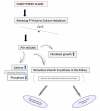A Review of the Relationship of the Cerebrospinal Fluid Changes During the Dysregulation of Parathyroid Hormone With Psychiatric or Neurological Manifestations
- PMID: 33604214
- PMCID: PMC7880852
- DOI: 10.7759/cureus.12679
A Review of the Relationship of the Cerebrospinal Fluid Changes During the Dysregulation of Parathyroid Hormone With Psychiatric or Neurological Manifestations
Abstract
It is established that normal calcium and vitamin D concentrations are maintained in the body through parathyroid hormone (PTH), a signaling molecule secreted from parathyroid glands. A massive role is played by PTH in increasing calcium levels when they are extremely low in the body through different mechanisms. The dysregulation of this hormone is due to either over functioning of the gland (hyperparathyroidism) or compromised functioning in hypoparathyroidism. A detailed review was done to identify if any changes are happening in the cerebrospinal fluid (CSF) due to any pathology causing the parathormone to be dysregulated enough to, in turn, cause any further pathology in the nervous system. This may then lead to various disabling neuropsychiatric features. The calcium and vitamin D abnormalities are both directly and indirectly connected to psychiatric features like delusions, schizophrenia, disabled cognition, psychosis, coma, mania, and depression of all kinds. Moreover, their irregularities are also linked to Alzheimer's. During these manifestations, the CSF is altered concentration-wise, where elevated calcium levels inside are observed during different studies. Despite PTH's indirect connection to the CSF modifications, their association hasn't been potently proven yet, considering more observational studies should be conducted in humans and for a more extended period, along with bigger and greater numbers of CSF samples. Suppose there is a possibility of the link of CSF alterations to PTH. In that case, we can consider a pronounced increase of CSF calcium or PTH as a risk factor for debilitating neuropsychiatric diseases. In this review, the possible correlation of CSF and PTH has been discussed.
Keywords: calcium & schizophrenia; calcium/cerebrospinal fluid"[mesh]; cerebrospinal fluid/physiology"[mesh]; csf & psychosis; csf & pth; parathyroid hormone/cerebrospinal fluid"[mesh]; psychiatry/physiology"[mesh]; pth & psychosis; vitamin d & depression.
Copyright © 2021, Kaleem et al.
Conflict of interest statement
The authors have declared that no competing interests exist.
Figures



References
-
- Physiology of parathyroid hormone. Goltzman D. Endocrinol Metab Clin North Am. 2018;47:743–758. - PubMed
-
- Mania in a case of hyperparathyroidism. Brown SW, Vyas BV, Spiegel DR. Psychosomatics. 2007;48:265–268. - PubMed
-
- Calcium channels, synaptic plasticity, and neuropsychiatric disease. Nanou E, Catterall WA. Neuron. 2018;98:466–481. - PubMed
Publication types
LinkOut - more resources
Full Text Sources
Other Literature Sources
